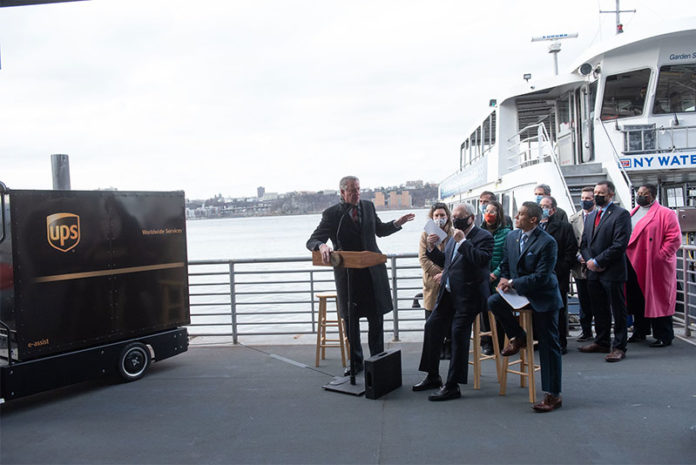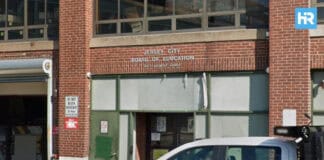NY Waterway is on board and ready to help with New York City’s plan to reduce roadway congestion by addressing reliance on trucks to deliver freight.
The commitment by the Hudson River-based ferry operator follows a recent announcement by New York City Mayor Bill de Blasio of approximately $38 million in new funding for freight programs.
“It’s our mission at New York Waterway to reduce congestion on the region’s roadways,” NY Waterway Chairman, President and CEO Armand Pohan said in a statement. “As the largest ferry fleet in New York Harbor, we stand ready to work with the City and with private partners to carry more freight on our passenger lines.”
Officials made the funding announcement on Dec. 15 on Pier 79 against the backdrop of a NY Waterway passenger ferry that will moonlight for freight use. NY Waterway ferries already carries some freight, but would see an increase under New York City’s new plan.
“For centuries, maritime freight was the core of New York City’s economy,” said de Blasio.” Now, it’s time to re-engage the blue highway that can make deliveries safer, faster, and more sustainable.”
That funding includes $18 million for the new Blue Highways pilot program, a joint effort between the New York City Department of Transportation (DOT) and the New York City Economic Development Corporation (EDC) to spur private investments in marine vessels to transport goods into and around the city. The program also encourages the use of sustainable last mile delivery solutions like electric trucks and commercial cargo bicycles.
“Our ferries can cross the Hudson in seven minutes, and are a fast way to bring small containerized shipments right to the heart of business districts in Midtown and Downtown,” Pohan said. “We look forward to becoming a green, sustainable alternative not only to private passenger cars, but now to freight trucks as well.”
Moving freight by ferry
Nearly 90 percent of New York City’s goods are moved by truck, the result of the shift from rail and water networks to highways in the second half of the 20th century. The DOT estimates that truck traffic across the Hudson River has increased by over 50 percent between January 2020 and September 2021.
Without action, the increase in freight demands will result in tens of thousands more trucks crossing into the city every day, while the network of streets and bridges remains fixed.
The growing dependency on trucks to meet an increasing demand for goods exacerbates traffic congestion, pollutes air, stresses aging infrastructure, and harms quality of life in residential neighborhoods, not only in New York City but also Hudson County which many trucks drive through on their final stretch to New York City.

The city’s new plan to address the reliance on trucks to move freight, dubbed Delivering Green, seeks to reverse those trends and move goods by water, rail and by other more sustainable modes of transportation.
Delivering Green lays out five goals to restructure freight distribution by: encouraging greener and more efficient truck deliveries; increasing the share of goods moved by water, rail, and cargo bicycles; and supporting new technologies to make freight movement more efficient and compliant.
“As our demand for freight continues to increase, we cannot continue the historic mistake of relying on more oversized and polluting diesel trucks to handle the load,” said DOT Commissioner Hank Gutman. “They destroy our infrastructure, damage the public health and quality of life in our neighborhoods, clog our already overcrowded streets and hasten climate change. We must change course. We have developed a thoughtful blueprint for the next five years to do just that. We are laying out a vision to reclaim New York City’s original highways — our harbor and rivers — to bring goods into the city and shifting to cargo bikes and other small, green vehicles to complete the journey to our doorsteps.”
Local resistance?
The announcement by NY Waterway may draw the ire of Weehawken residents, many of whom have come out against the company’s plans to expand its re-fueling and maintenance facility in the township. The ferries hauling freight to and from the city would need to refuel and undergo maintenance amid the increased usage under the new plan.
Residents have criticized NY Waterway for an alleged lack of transparency about its intentions for the facility, its noise and air pollution, and other issues, mobilizing and forming an opposition group known as Weehawken Residents Against Ferry Pollution. Meanwhile, the ferry operator has defended its plans, stating that it has always been clear about its intentions for the site, claiming that the new configuration would decrease pollution.
Mayor Richard Turner is skeptical of the company’s plan ever coming before the Weehawken Planning Board and voiced his concerns calling it a “difficult sell,” but also encouraged residents not to prejudge an application before its submitted to the board for legal reasons. However, residents remain steadfast in their opposition to NY Waterway and its plans.
Most recently, residents met with state Assemblyman Raj Mukherji, who represents the 33rd Legislative District which encompasses Weehawken, to demonstrate their home’s close proximity to the current facility and voice their concerns about the potential planned expansion.
The resistance to NY Waterway’s plans will surely continue, despite the fact that an application for final site plan review has not yet been heard before the planning board.
For updates on this and other stories, check www.hudsonreporter.com and follow us on Twitter @hudson_reporter. Daniel Israel can be reached at [email protected].






